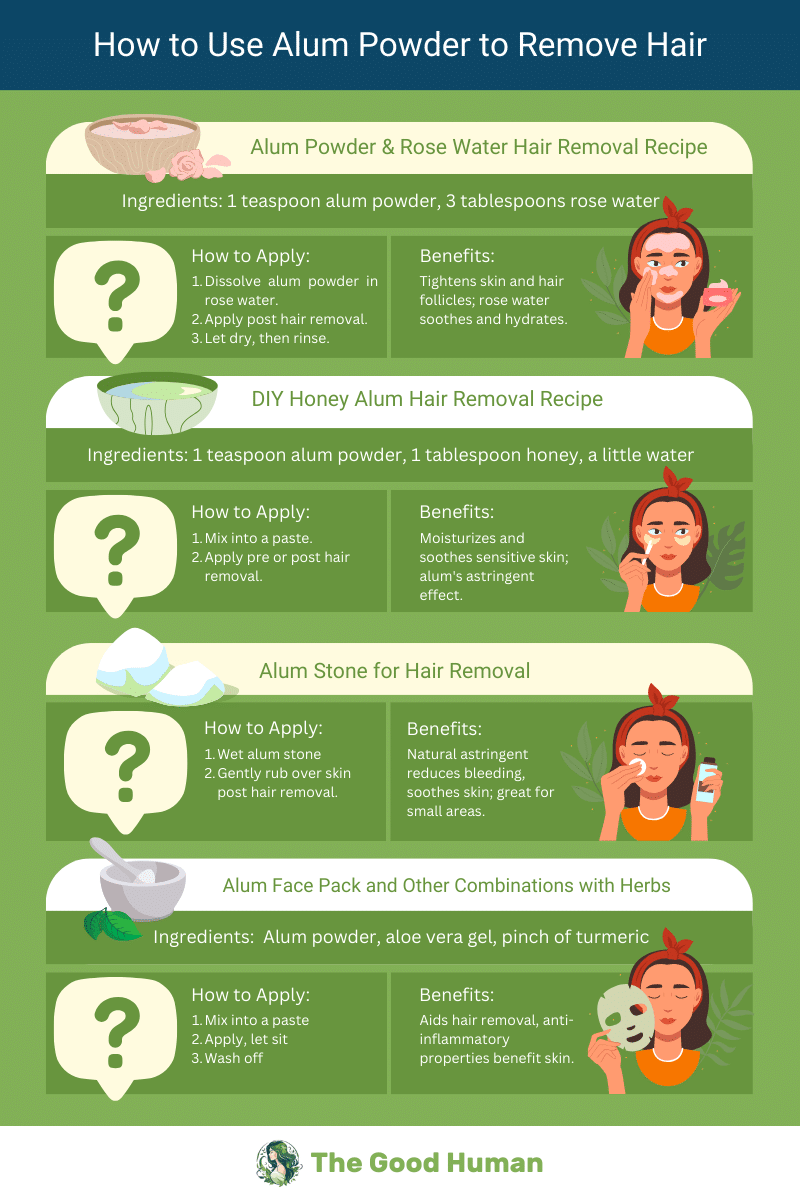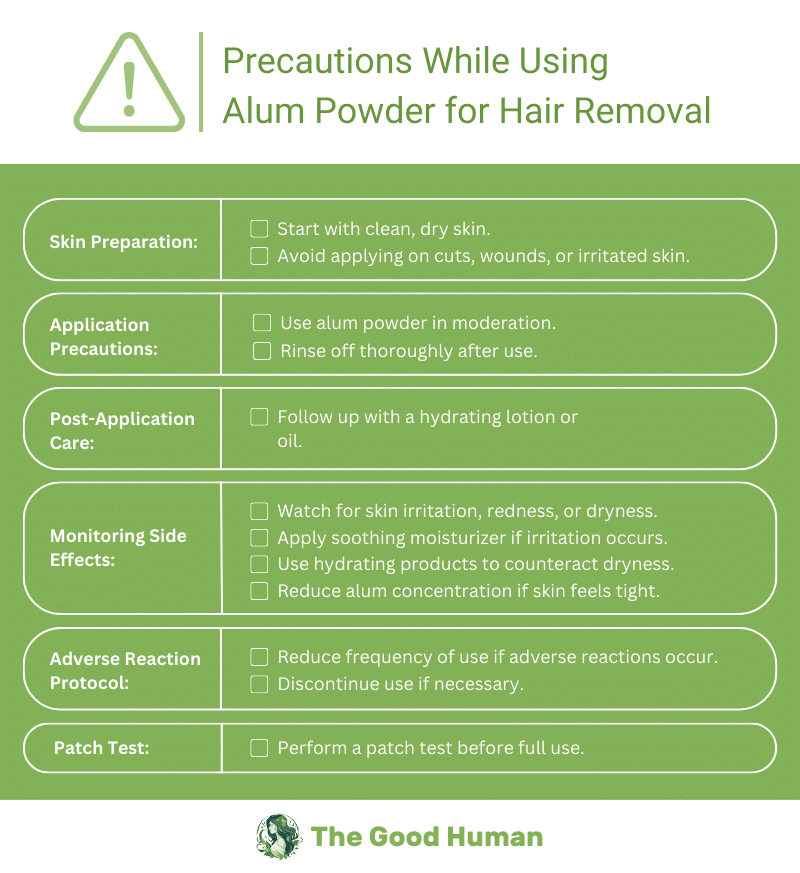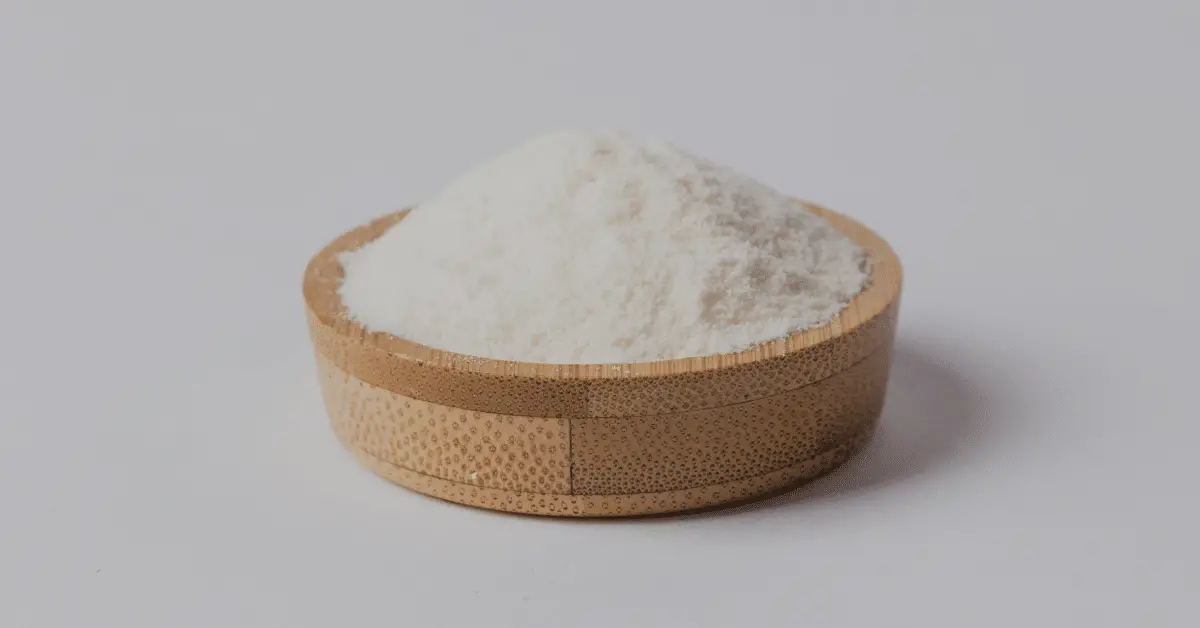Have you ever wondered, “does alum powder remove hair?” This age-old remedy, often tucked away in your kitchen or first-aid kit, might hold the answer to your hair removal needs.
Alum powder aids in hair removal by contracting hair follicles. This natural mineral, known for its astringent properties, makes hair removal easier while offering skin-soothing benefits.
Dive deeper into the world of alum powder with us. Discover its types, uses, and effective hair removal recipes, all while learning about its skin benefits and necessary precautions.
What is Alum Powder?
You’ve likely encountered alum powder in various contexts, but what exactly is it? This seemingly ordinary powder has a rich history and diverse applications, making it a staple in many households and industries. Let’s delve into its definition and the variety of types available.
Definition and Chemical Composition
Alum powder is more than just a household name. It’s a chemical compound that primarily consists of potassium aluminum sulfate. This naturally occurring mineral is known for its crystalline form and astringent properties. Its unique chemical composition makes it both versatile and effective in various applications, ranging from culinary uses to water purification.
Understanding the different types of alum is key to appreciating its versatility. Each type has its own specific chemical composition and properties, making them suitable for various applications. From the commonly used potassium alum to the more specialized types like chrome and selenate alums, the diversity within this family of compounds is vast.

Types of Alum
Let’s break down the different types of alum. Each one has a unique chemical makeup and use, adding to the versatility of this compound.
Potassium Alum
Potassium alum, also known as potash alum, is perhaps the most well-known type. It’s primarily used in water purification, leather tanning, and as a flocculating agent. Its safety and efficacy have made it popular in both industrial and personal care applications.
Sodium Alum
Sodium alum is similar to potassium alum but contains sodium instead of potassium. It’s often used in the food industry as an acidity regulator and stabilizer. Its ability to maintain the color and texture of foods makes it an important ingredient in the culinary world.
Ammonium Alum
Ammonium alum, comprising ammonium and aluminum sulfate, is used in a variety of applications. It’s often found in deodorants and antiperspirants, thanks to its astringent properties. This type of alum is also used in water purification and dyeing processes.
Chrome Alum
Chrome alum is distinguished by its deep purple color, a result of the chromium content. It’s primarily used in the tanning of leather and in the photographic industry. Its unique properties make it crucial in these specialized applications.
Selenate Alums
Selenate alums are less common but serve important roles in certain chemical processes. These types of alums are used in specialized laboratory procedures and in certain types of manufacturing processes, showcasing the chemical diversity within the alum family.
Aluminum Sulfate
Aluminum sulfate, another form of alum, is widely used in water treatment plants. It helps in purifying water and is also used in gardening and horticulture to adjust soil pH levels. Its widespread use in environmental management highlights its importance.
Common Uses of Alum Powder in Various Fields
Alum powder’s shelf-life and versatility extends beyond just chemical composition. From food preservation to industrial applications, alum powder has a multitude of uses. It’s a wonder ingredient in many fields, each utilizing its unique properties for specific purposes.
In the culinary world, alum powder is used as a firming agent in pickling recipes. It helps maintain the crunchiness of pickles, making it a favorite among home cooks. In the pharmaceutical industry, its astringent and antiseptic properties make it an ingredient in various ointments and tonics. Alum powder also plays a significant role in water treatment processes, showcasing its environmental applications.

Exploring the Claim: Alum Powder for Hair Removal
Now, let’s explore the intriguing claim about alum powder’s role in hair removal. This natural compound, known for its astringent properties, is often rumored to be an effective hair removal agent. Understanding how it works and its role in hair removal products will give us a clearer picture of its efficacy.
How Alum Powder Works for Hair Removal
Alum powder’s effectiveness in hair removal lies in its astringent properties. When applied to the skin, it causes minor coagulation of protein in the skin cells. This action helps in tightening the skin and shrinking hair follicles, making it easier to remove hair from the root.
The process of using alum for hair removal typically involves applying a mixture of alum powder and water to the skin before or after hair removal methods like waxing or threading. The tightening effect of alum not only aids in easier hair removal but also reduces bleeding and soothes the skin post-removal. This makes it particularly popular in traditional hair removal practices.
The Role of Alum in Depilatory Waxes and Post-Hair Removal Care
Alum powder is not just used alone; it’s often a component in depilatory waxes and post-hair removal care products. In waxes, it helps in gripping the hair better, ensuring a more effective removal. This integration with waxing products underscores its significance in the beauty and personal care industry.
Post hair removal, alum acts as a natural antiseptic and astringent. Applying alum after waxing or threading can help soothe the skin, reduce redness, and prevent bacterial infections. Its healing properties make it a preferred choice for many seeking natural aftercare options. This dual role in both the hair removal process and aftercare solidifies its standing as a useful and multifaceted natural remedy.
How to Use Alum Powder for Hair Removal
Now that we’ve explored what alum powder is and its role in hair removal, let’s dive into how you can use it effectively. There are various methods and recipes that leverage the hair-removing capabilities of alum powder. Whether you’re a prepper looking for natural alternatives or simply curious about traditional beauty practices, these techniques are worth trying.
Various Methods and Recipes
Using alum powder for hair removal can be both effective and economical. There are several methods to incorporate this versatile compound into your hair removal routine, each tailored to different needs and preferences. From simple mixes to more elaborate recipes, alum powder can be easily adapted to suit your hair removal process.
Alum Powder & Rose Water Hair Removal Recipe
One popular method combines alum powder with rose water. To prepare this mixture, dissolve a teaspoon of alum powder in three tablespoons of rose water. Apply this solution to the area after hair removal, let it dry, and then rinse off. This method is effective because the alum tightens the skin and hair follicles, while the rose water soothes and hydrates the skin, making it a gentle yet effective hair removal aid.

DIY Honey Alum Hair Removal Recipe
For a nourishing touch, try the honey alum recipe. Mix a teaspoon of alum powder with a tablespoon of honey and a little water to form a paste. Apply this mixture before hair removal to prep the skin, or after to soothe and tighten. Honey’s natural moisturizing properties combined with alum’s astringent effect make this recipe particularly beneficial for sensitive skin.
Using Alum Stone for Hair Removal
Alum stone, a more solid form of alum, can also be used for hair removal. Wet the stone and gently rub it over the skin after hair removal. The stone’s natural astringent properties help reduce bleeding and soothe the skin. This method is particularly useful for small areas like the eyebrows or upper lip.
Alum Face Pack and Other Combinations with Herbs
Another method involves creating an alum face pack. Mix alum powder with aloe vera gel and a pinch of turmeric to form a paste. Apply this to the face or other areas, let it sit for a few minutes, then wash off. This combination not only aids in hair removal but also benefits the skin, thanks to the anti-inflammatory properties of aloe vera and turmeric.

Why Combine Alum with Rosewater?
Combining alum with rosewater is not just a traditional practice, but it also has numerous benefits for your skin, especially in the context of hair removal. This combination balances the potent effects of alum with the soothing properties of rosewater. Understanding the synergy between these two ingredients can help you make the most of your hair removal routine.
Benefits of Using Rosewater with Alum
Rosewater, known for its soothing and hydrating properties, complements the astringent nature of alum powder. When used together, they provide a balanced approach to hair removal. The rosewater helps to mitigate any potential irritation caused by alum, making the process gentler on your skin. This combination is particularly beneficial if you have sensitive skin or are looking for a more soothing hair removal experience.
How Rosewater Enhances the Effects of Alum in Hair Removal
The addition of rosewater to alum not only soothes the skin but also enhances the overall effectiveness of the hair removal process. Rosewater helps in evenly spreading the alum across the skin, ensuring a more uniform application. This results in a more effective tightening of the skin and hair follicles, leading to an easier and more efficient hair removal process.
The Role of Rosewater in Moisturizing and Soothing the Skin
Rosewater’s role extends beyond just aiding the hair removal process. It acts as a natural moisturizer, helping to hydrate and rejuvenate the skin after the drying effects of alum. The anti-inflammatory properties of rosewater also help in reducing redness and calming the skin, making it an ideal post-hair removal treatment. This combination of alum and rosewater ensures that your skin remains smooth and irritation-free, making your hair removal experience as comfortable as possible.
Time Frame for Hair Removal with Alum
When integrating alum powder into your hair removal routine, it’s important to understand the expected time frame for seeing results. Alum powder works differently than conventional hair removal methods, and several factors can influence its effectiveness. As you explore its use, remember that patience and observation are key to determining how well it works for you.
How Long Does It Take to See Results with Alum?
When using alum powder, immediate effects like skin tightening and soothing are often noticeable right after hair removal. However, for long-term effects like reduced hair regrowth, consistent use over several weeks or months is typically required. This gradual impact is due to the astringent properties of alum, which work over time to slow down hair growth.
For those looking for a noticeable decrease in hair growth, patience is key. Regular application of alum, in conjunction with your chosen hair removal method, will yield the best results. Remember, the effectiveness of alum varies from person to person, so observing how your skin and hair respond over time is crucial.
Factors Affecting the Time Frame
The nature of your hair plays a significant role in how quickly you’ll see results with alum. Thicker, coarser hair may require more frequent applications and longer usage to achieve noticeable effects. Conversely, those with finer hair might see quicker results.
The method of hair removal used also affects the efficacy of alum. Methods like waxing or epilating, which remove hair from the root, may enhance the effects of alum compared to shaving. Understanding these factors will help you set realistic expectations and tailor your hair removal regimen accordingly.
Precautions and Side Effects
Using alum powder for hair removal is generally safe, but being aware of possible side effects and taking appropriate precautions is vital. This ensures the health and safety of your skin while using a natural hair removal method. Let’s look into the precautions you should take and the potential side effects to be aware of.
Precautions While Using Alum Powder for Hair Removal

When using alum powder, it’s crucial to start with clean, dry skin. Avoid applying alum on cuts, wounds, or irritated skin areas to prevent stinging or further irritation. If you have sensitive skin, be extra cautious, as alum can sometimes cause dryness or tightness.
To ensure safe use, apply alum powder in moderation and always rinse it off thoroughly after use. Following up with a hydrating lotion or oil can help counteract any dryness caused by the alum. This way, you can enjoy the benefits of alum without compromising your skin’s health.
Potential Side Effects and How to Mitigate Them
Side effects from using alum powder are generally rare but can include skin irritation, redness, or dryness.
- Skin Irritation: Some people might experience redness or itching. To mitigate this, use alum powder in moderation and always follow with a soothing moisturizer.
- Dryness: Alum can dry out the skin. Counteract this by applying a hydrating lotion or oil after its use.
- Tightness in Skin: This is a common sensation due to alum’s astringent properties. If uncomfortable, reduce the concentration of alum in your mixture.
The key is to listen to your skin. If you experience any adverse reactions, reduce the frequency of alum use or discontinue it altogether. Always prioritize your skin’s health and comfort.
Importance of Patch Tests and Frequency of Use
Before fully integrating alum into your hair removal routine, performing a patch test is critical. Apply a small amount of the alum solution to a discreet skin area and wait for 24 hours to observe any reactions. This test will help you gauge your skin’s tolerance to alum.
Frequency of use should be adjusted based on your skin’s response. Some may tolerate frequent use, while others might need to limit it to once or twice a week. Overuse can lead to irritation or dryness, so finding the right balance for your skin type is essential.
Comparative Analysis
To fully appreciate the role of alum in hair removal, it’s useful to compare it with other natural methods. This comparison will help you understand where alum stands in terms of effectiveness, ease of use, and skin sensitivity. Let’s see how alum powder fares against other natural hair removal options.
Comparison of Alum Powder Hair Removal with Other Natural Methods
Alum powder, in the realm of natural hair removal, has a unique position. Unlike methods like sugaring or threading, which directly remove hair, alum assists in the process and provides post-removal skin care. It’s particularly noted for its ability to slow down hair growth over time, a feature not common in other natural methods.
While alum doesn’t remove hair by itself, it enhances the effectiveness of other methods. Its ease of use, especially when mixed with ingredients like rose water or honey, makes it a convenient addition to natural beauty routines. However, its gradual impact on hair growth requires consistent and prolonged use to be effective.
Effectiveness, Ease of Use, and Skin Sensitivity Comparisons
Compared to other natural hair removal methods, alum powder serves more as a supplementary treatment. It’s easy to use and integrate into existing routines, which is particularly beneficial for those with sensitive skin. Alum offers a gentler alternative to some mechanical or chemical methods, reducing the risk of severe irritation or skin damage caused by toxic chemicals.
However, in terms of immediate hair removal effectiveness, methods like threading or sugaring take precedence. Alum powder’s strength lies in its long-term effect on hair growth and skin health. It’s a valuable component for those seeking a comprehensive and natural approach to hair removal and skin care.
Alum Powder in Hair Removal: A Natural Approach
In summary, alum powder can be a valuable addition to your hair removal routine. Its natural astringent properties not only aid in the hair removal process but also care for the skin, making it a multifaceted option for those looking for natural solutions.
As a final recommendation, remember to use alum powder responsibly. Conduct patch tests before regular use, monitor your skin’s response, and combine it with soothing agents like rose water or honey for the best experience.
Whether you’re a prepper seeking natural alternatives or someone exploring traditional beauty practices, alum powder offers a unique approach to hair removal that is worth trying. Remember, patience and consistency are key to seeing significant results with this natural remedy.







